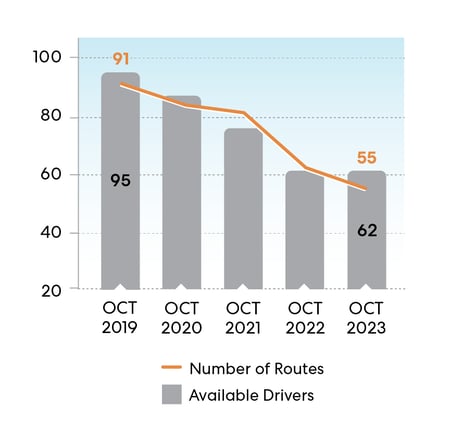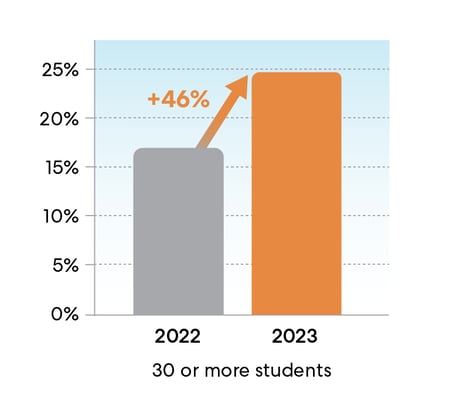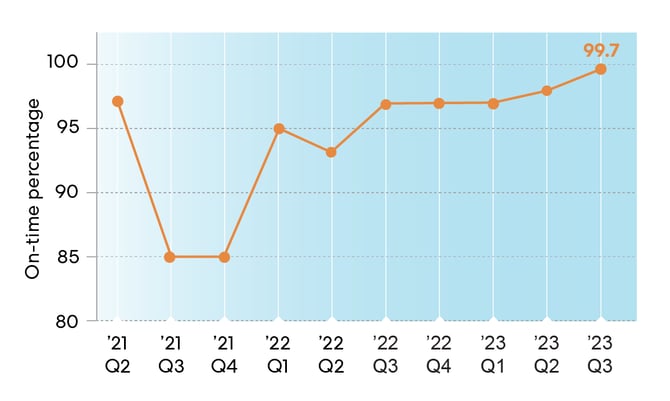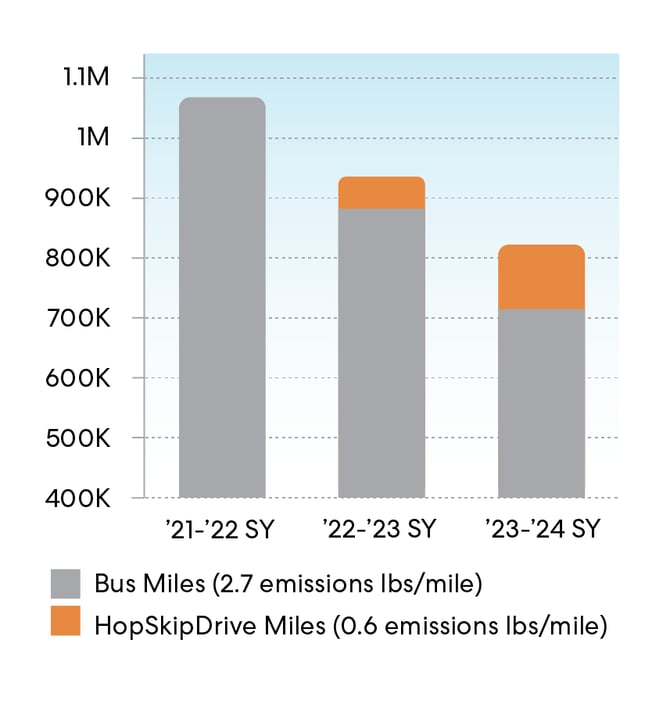Last fall, our entire team was up against a massive driver shortage and working tirelessly to get students to school safely and as close to on-time as possible. We had routers, trainers, and other CDL-trained administrators driving on a daily basis. I’m so impressed with our team’s ability to work with HopSkipDrive and innovate amidst these operational challenges.
Kris Odom
D11 Chief Operating Officer
Colorado Springs School District 11: How HopSkipDrive RouteWise AI™ Is Helping Solve the Bus Driver Shortage
About Colorado Springs School District 11
Colorado Springs School District 11 (D11) is the central school district in Colorado Springs, CO, and has been serving the community for 151 years. Today, the district includes 58 schools serving a student population of over 23,000.
D11’s transportation team provides over 5,400 student trips daily, driving over 750,000 miles per year to support D11 students.

Before HopSkipDrive:
A need for supplemental transportation
Like 92% of districts around the nation, D11 was struggling with severe bus driver shortages that led to reduced services, routine lateness, and frustrated families, students, and educators.
With a large population of students and fewer bus drivers on the road than ever, D11 had no choice but to ask its routing and training team to get behind the wheel, calling all hands on deck to help get students to school. With the transportation team driving routes, they lacked the time to spend on finding solutions to the challenges they were facing, from accommodating field trip requests to finding long-term solutions to the shortage. And, still lacking enough drivers, the district had no choice but to pack school bus routes with as many stops as possible, leaving little room for delay and making it difficult for buses to reliably arrive on time.

HopSkipDrive’s Impact
HopSkipDrive’s RouteWise AI team worked with D11’s transportation team to collaborate on solutions, identifying specific recommendations to improve the entire transportation plan.
Knowing that D11’s most urgent challenge was the school bus driver shortage, the RouteWise AI team worked with D11 to identify opportunities to improve route efficiency and increase utilization of bus routes. Simultaneously, HopSkipDrive found places where existing routes would be best supplemented with small vehicles, helping to free up extra buses for high occupancy routes.
Optimized routes and vehicle mix
D11 initially budgeted for 112 drivers for the 2022-2023 school year, yet only 61 drivers started the year; D11 had lost 36% of their drivers since 2019 and were operating with more routes than drivers.
With HopSkipDrive support, D11 further consolidated bus routes to return to balanced operations during the 2023-2024 school year, with 62 drivers and 55 optimized bus routes. As part of a data-driven route optimization, D11 replaced underutilized routes with HopSkipDrive rides, enabling D11’s bus drivers to drive fuller buses, all without increasing operating budget.
Because of RouteWise AI’s recommendations and D11’s insight, the impacts of these changes were immediately felt. Fewer bus routes, optimal utilization of existing routes, and small vehicle supplementation alleviated the effects of the bus driver shortage. This led to:
Increased efficiency
D11 was able to increase its share of high-utilization bus routes (defined as 30 students or more) by 46%.
Number of D11 Drivers and Routes

Share of Runs Highly Utilized - Actual Ridership

When we started, we had bus routes without drivers, furious parents, overwhelmed staff, and kids missing invaluable learning time. That is all changing. Our creative and hard-working transportation team, in partnership with HopSkipDrive RouteWise AI, is transforming our district’s approach to transportation. I’m proud of how our team and community embraced HopSkipDrive’s innovative portfolio approach, which is now ensuring all kids in the district have safe and reliable access to a high-quality education. I am charging our team to continue innovating with HopSkipDrive and create additional efficiencies and service improvements for next school year.
Michael Gaal
D11 Superintendent
Improved on-time arrivals
D11 was able to increase on-time bus and vehicle arrival rates from 85% to 99%, recovering over 17,000 hours for D11 students in the classroom. More time spent learning, not commuting, will mean better educational outcomes for D11 students.
Increased driver pay
By right-sizing operations, D11 was able to close long-vacant budgetary lines and use those savings to fund a significant driver raise.
Returning administrative team to their core roles
With a balanced staffing model and coverage planned, the administrative team of routers, trainers, and supervisors was able to step back from daily driving responsibilities and return to their core responsibilities.
Cost savings
D11 identified opportunities to reduce their transportation capital budget by 40% over 10 years by increasing vehicle utilization, right-sizing their fleet, and utilizing more efficient routes.
Reducing carbon footprint
With route consolidation and substituting more efficient sedans for some under-utilized buses, D11 reduced transportation carbon emissions by 31%.
Looking to the future
D11’s transportation administration can focus on working with HopSkipDrive on further innovation.
Morning On-time Arrival Rates

Reduction in Planned Miles

Conclusion:
The partnership between Colorado Springs School District 11 and HopSkipDrive exemplifies how a strategic partnership and innovative solutions can address complex transportation challenges.
By applying RouteWise AI’s technology to D11’s foundational local expertise, D11 was able to resolve its immediate bus driver shortage and pave the way for more efficient, cost-effective, and reliable school transportation for years to come. Through this partnership, D11 is securing a brighter future for its students, ensuring they have access to quality education and valuable experiences.
About HopSkipDrive RouteWise AI™ Technology
In contrast to other routing solutions on the market, HopSkipDrive RouteWise AI does not simply show the outcome of decisions routing specialists are left to make on their own — it delivers a comprehensive package of route recommendations that specialists can easily review, edit, and implement. It also supports a broader transition to a multimodal approach to student transportation, helping transportation teams develop a plan to fully utilize their buses and effectively supplement with smaller vehicles.
- This work begins with a Custom Model Design Workshop with the RouteWise AI team. This process uncovers on-the-ground realities and nuances unique to a district such as scheduling intricacies, preferences for transportation of riders of various age groups or student categories, budget or staffing constraints, loading and unloading times, vehicle speeds, and more.
- RouteWise AI then builds a custom model of our AI-powered machine learning engine, based on the district’s unique needs. This in-house technology runs millions of scenarios with optimization algorithms, identifying proposed routes and vehicles tailored to each student. Throughout the process, our RouteWise AI analysts manage the output, making changes, adjustments, and amendments to the algorithms — a process that can cover hours or days depending on the complexity.
- The result is a package of routes designed to meet the district’s goals, as well as a number of scenarios, brought to life through advanced data visualizations. These include visualizations of route coverage and fleet use, budget impacts for different staffing models, and vehicle capacity checks.
- The route recommendations are ready to be reviewed, adjusted, and implemented seamlessly by the district routing team, with partnership from the HopSkipDrive RouteWise AI team.
